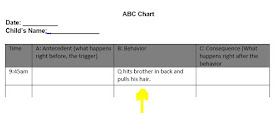You have heard me say that I LOVE talking about behavior.
This week on our Facebook Live, we talked about the benefit of tracking behaviors using an ABC chart. You can see that video here.
All behaviors that we engage in have a FUNCTION. This means that everything we do has a way of accomplishing SOMETHING. The same is true for challenging behaviors. Children engage in challenging behaviors in order to accomplish SOMETHING. This SOMETHING is the FUNCTION of behavior. When we document behavior using an ABC chart, it gives us clues to figure out the FUNCTION of the behavior.
You can get a copy of the chart here. This is a Google document, you will click "make a copy" and then you will be able to type right in. If this doesn't work, you can use this form below:
Let me show you how you will use this form.
I suggest using one form for each day.
1. Write the time the behavior incident occurred.
This will be important for finding patterns. For example, you will be able to look over a period of days or weeks to see that the majority of behavior incidents are occurring in morning. This will be a clue.
2. Fill in the B column. You will write exactly what the behavior looked like.
Avoid writing things like "threw a tantrum" or "fought her brother." These terms do not tell us exactly what is happening.
3. Think back to what happened RIGHT before the behavior occurred. Write this in the A column.
This will be the trigger or setting event. Overtime, a list of antecedents will prove helpful in our detective work!
4. In the C column, write what happens right after the behavior incident.
In the C column, I wrote what happened right after Q hit her brother. This gives us a clue to the function or what the behavior is ACCOMPLISHING.
Why is it important to collect this information in this way?
The goal of collecting this data is to find out why the children are engaging in these behaviors. Once we know the WHY or what the behaviors are ACCOMPLISHING, we can teach children a replacement behavior that is more appropriate. You can take this documentation to IFSP or IEP meetings. Everyone will be so thankful! You have a big chunk of the work already done!
Follow along for more info:
Keep following the page or the blog for the next step in the process. We will be looking at how we determine the WHY or FUNCTION of the behavior is.





No comments:
Post a Comment